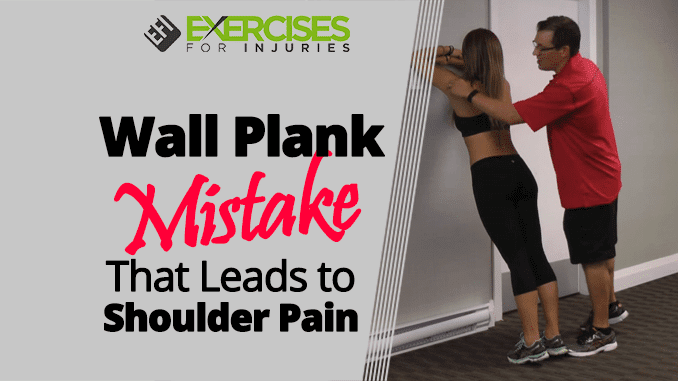The shoulder is one of the most mobile joints in the body, which means it is not the most stable. The shoulder joint, or glenohumeral joint, is a ball and socket between the scapula (shoulder blade) and humerus (upper arm bone). The head of the humerus sits in the socket of the shoulder blade. The rotator cuff muscles surround the shoulder joint and ensure the head of the humerus stays in the shoulder blade socket.
Due to its structure, the shoulder joint is commonplace for injury and pain. Taking good care of the shoulder joint includes using good form in exercises involving the upper body. In this video, I wanted to go through a common mistake that I see people make relating to the Wall Plank, which leads to shoulder pain and injury. In this post, I will show you how to do the Wall Plank exercise properly to avoid injury and pain.
Shoulder Injury Symptoms
Shoulder injuries include decreased range of motion, stiff and painful movements, a feeling that the shoulder could pop out of the socket, or weakness in the shoulder area. Most shoulder injuries can be treated at home with rest and ice.
However, you may need to see a doctor if your injury is more severe. Some more serious symptoms include a deformed-looking shoulder joint, inability to use your shoulder, intense pain, sudden swelling, and weakness or numbness in the arm or hand.
Many different things can cause shoulder pain. Some common causes include dislocation[¹], separation, fractures, cartilage tears, rotator cuff tears, frozen shoulder, impingement, and bursitis. Your shoulder pain may also be caused by osteoarthritis, rheumatoid arthritis, referred pain, tendinitis, and bone spurs.
Before you experience shoulder pain, see if you can prevent it altogether. You can use some simple strategies daily to protect your shoulders. First, ensure your chair has proper back support and helps you maintain good posture. Take regular breaks throughout the day if you sit a lot to move around, at least once every hour. When you are lifting heavy objects, ensure you face what you are lifting, keep your back straight, bend your knees, and use your legs for strength. Last, make sure you regularly strengthen and stretch the muscles in and around your shoulders.
CLICK HERE to watch the YouTube video.
Wall Plank Position Mistake
I had Alix demonstrate it.
Wall Plank Position Mistake
In the image above, Alix moves into a Wall Plank position with the common mistake that people make: the arms are too high, putting a lot of stress on the shoulders and collar bones. This unnecessary stress leads to irritation[²], injury, and pain.
Proper Wall Plank Position
We want to do the Wall Plank position properly.
We need to have the elbows and forearms below shoulder height. Keep your shoulders down from your ears, and your shoulder blades pulled together. Your core should pull toward your spine and avoid rounding your lower back. By doing this, the shoulder blade muscles pick up the work, and less stress is placed on the shoulder joint.
Proper Wall Plank Position
There you go! Next time you do the Wall Plank, ensure you are not making that mistake, and your shoulders will be happy for it.
Final Word
Make sure to swing by ExercisesForInjuries.com. Enter in your injury or pain. There’s a good chance that there’s an article, an interview, or a video to help you overcome your injury or pain.
Secondly, if you’re watching this on YouTube, head up above and hit subscribe. When you subscribe, you’ll get a video like this every couple of days where I talk about tips and tricks on overcoming injury or pain.
Thirdly, head down below, hit like, and leave me a question or a comment.
Take care!
Rick Kaselj, MS
If you want to end your shoulder pain permanently, click here to check out the Shoulder Pain Solved program.
References:
- Jadib, I., Bouhouche, M., Hadad, O., Messoudi, A., & Rafai, M. (2024). Isolated pure posteromedial tibiotalar joint dislocation unassociated with fracture: A case report. International Journal of Surgery Case Reports, 121, 109933. https://doi.org/10.1016/j.ijscr.2024.109933
- Wu, W., Yu, R., Hao, H., Yang, K., Jiao, G., & Liu, H. (2023). Visible trephine-based foraminoplasty in PTED leads to asymmetrical stress changes and instability in the surgical and adjacent segments: a finite element analysis. Journal of Orthopaedic Surgery and Research, 18(1). https://doi.org/10.1186/s13018-023-03916-0

